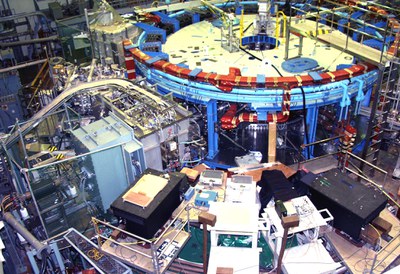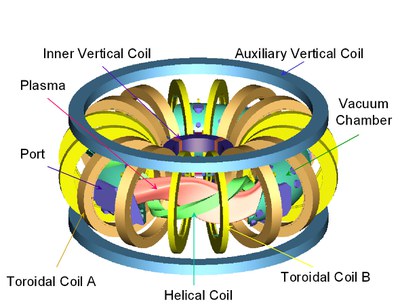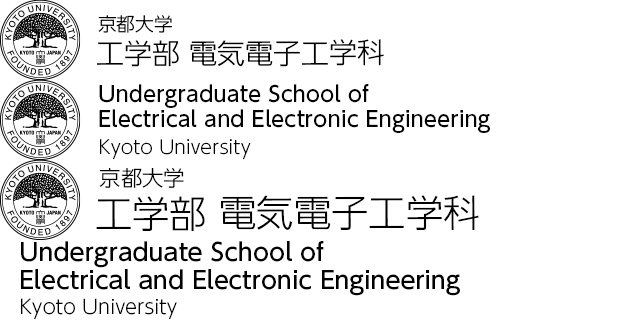Complex Plasma System (High-temperature Plasma Physics)
We are working to clarify the kinetic and magneto-hydrodynamic nature of ultra-high-temperature plasmas for nuclear fusion, using empirical and theoretical simulations, and conducting research and education to explore the principles and applications of the generation, heating, and control of high-temperature plasmas. Specifically, we are using Kyoto University's Heliotron J to perform empirical and theoretical research to investigate the relevant underlying physics principles for improving the confinement of quasi-isodynamic magnetic fields and for optimizing the magnetic field, for the purpose of developing a next-generation helical system high-temperature plasma confinement device.
Heliotron J
Currently, research to explore sophisticated magnetic field configuration aimed at developing and improving magnetic field confinement nuclear fusion is being undertaken at special facilities in a number of countries around the world—at large-scale helical experimental devices including LHD (National Institute for Fusion Science, Japan) and Wendelstein 7-X (Max Planck Institute, Germany), and small to medium-size helical devices including HSX (University of Wisconsin, U.S.A.), NCSX (Princeton Plasma Physics Laboratory, U.S.A.), H-1NF (Australian National University, Australia), and TJ-II (CIEMAT, Spain). Since 2000, plasma experiments have also been conducted using Heliotron J, a machine designed and located at Kyoto University. In view of these international research trends, plasma experiments have also been conducted since 2000 using Heliotron J at Kyoto University, for the purpose of optimizing the helical-axis heliotron configuration, an advanced magnetic field configuration developed by the University. This device, which is the only one of its kind in the world, is contributing significantly to the understanding of plasma confinement characteristics in a new range of parameters. The multi-layering of magnetic axes is expected to result in effective combination of good confinement characteristics and better MHD stability through magnetic wells, so that remarkable improvement in the confinement characteristics of currentless plasma can be anticipated.


Heliotron J specifications: coil no. of poles = 1, pitch no. = 4, single helical coil; two types, each with eight toroidal coils, and three pairs of poloidal coils; donut-shaped vacuum chamber of major radius 1.2 m, inside which is a confinement space (approx. 0.8 m3) of magnetic field strength 1.5 T. Using this coil system to expand the control degrees of freedom of the basic magnetic field factors (toroidal, helical, bumpy) enables the cultivation of new parameter spaces and flexible experimentation in electromagnetic field configuration research.
This experimental device can be used not only to elucidate the fundamental behavior of high-temperature plasma in hybrid and complex systems, but also to conduct effective research on plasma physics and the interaction between plasma and solids, to further promote basic nuclear fusion research through the integration of nuclear fusion science and furnace engineering.
Specific research details and special research themes
We are conducting empirical and theoretical analysis on plasma confinement making use of the Heliotron J, a plasma confinement device developed based on the heliotron line, which was originally invented by Kyoto University and is currently playing a world-leading role. This research group conducts advanced experiments and analysis on plasma, using a variety of its own state-of-the-art measurement facilities—including a neutral beam injection system, a radio-frequency plasma heating system, and a laser Thomson scattering system. In addition, we actively pursue fundamental research in the fields of theory and simulation, utilizing a large number of vector calculators, workstations, and PCs, and an excellent distributed computing environment. We also enjoy many opportunities for direct contact with overseas researchers.
The need for more basic research on the behavior of high-temperature plasmas for application to nuclear fusion—in particular to understand the transport of plasma across a magnetic field in direct relation to confinement—is increasing all the time. In view of this, our lab engages in a wide range of work relating to the transport and heating of high-temperature helical system plasma, specifically: (1) magnetic surface topology; (2) particle kinetic theory and magneto-hydrodynamic (MHD) characteristics; (3) confinement in energy relaxation process of high-energy particles; (4) empirical research on neutral beam injection (NBI) heating, electron cyclotron heating (ECH), and ion cyclotron heating (ICRF); (5) research on theoretical and numerical simulations; and (6) design and development of peripheral devices for heating and measurement.
Specific research themes are listed below.
- Experimental analysis on improved confinement in Heliotron J
- Experimental analysis on NBI heating and ICRF heating with Heliotron J
- Development of new Monte Carlo computation scheme for simulation of plasma transport and heating
- Theoretical analysis using the adiabatic invariant of charged particle orbits in non-axisymmetric systems (application to Hamiltonian dynamics)
- Research to improve the performance of stellarator magnetic fields based on controlling the chaos and statistical characteristics of magnetic field lines
By pairing each theme with a research team we also strive to provide suitable research guidance to all team members, extending the individuality of each one. We hold monthly seminars, where the academic staff and graduate students involved in each particular field meet and hold broad-ranging discussions regarding their research work.
Academic Staff
Hiroyuki OKADA
Associate Professor (Institute of Advanced Energy)
Research Interests
Contacts
Satoshi YAMAMOTO
Assistant Professor (Institute of Advanced Energy)
Research Interests
Contacts
